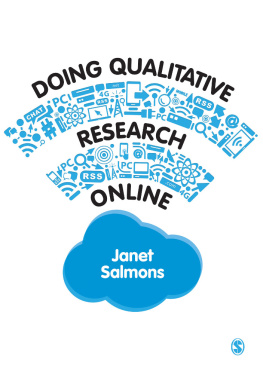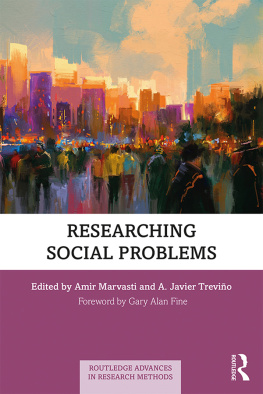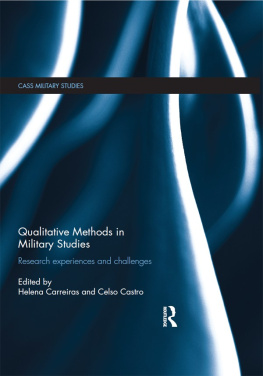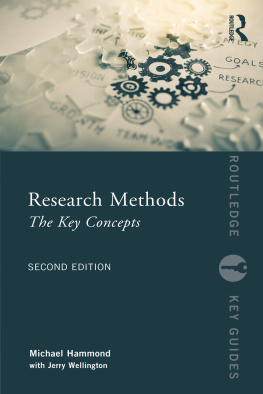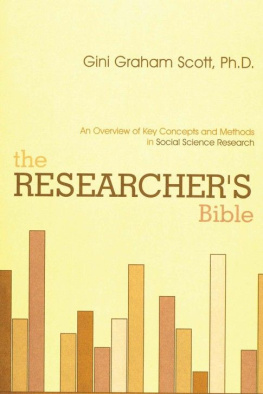For Jan
First published 1993 by Allen & Unwin
Published 2020 by Routledge
2 Park Square, Milton Park, Abingdon, Oxon OX14 4RN
605 Third Avenue, New York, NY 10017
Routledge is an imprint of the Taylor & Francis Group, an informa business
Allan Kellehear 1993
All rights reserved. No part of this book may be reprinted or reproduced or utilised in any form or by any electronic, mechanical, or other means, now known or hereafter invented, including photocopying and recording, or in any information storage or retrieval system, without permission in writing from the publishers.
Notice:
Product or corporate names may be trademarks or registered trademarks, and are used only for identification and explanation without intent to infringe.
National Library of Australia Cataloguing-in-Publication entry:
Kellehear, Allan.
The unobtrusive researcher.
Bibliography.
Includes index.
ISBN 1 86373 513 5.
1. Social sciencesResearch. I. Title.
300.72
Set in 10/11.5 pt Garamond by DOCUPRO, Sydney
ISBN-13: 9781863735131 (pbk)
This book has been written for the growing number of people who believe that there is, or that there should be, more to social research than either surveys or in-depth interviews. Much valuable insight can be gained about ourselves and the lives that we lead by simply listening and watching both systematically and with care. Furthermore, a significant amount of this work can be conducted without either engaging with or disturbing the activity of other people. In other words, much of this research is unobtrusive.
For the unobtrusive researcher, then, the serious study of the life and times of humanity can be found in the thousands of examples and products of our activities: behaviour, dress, organisational spaces, household objects, photographs, books, official statistics, personal diaries, film, music, food and countless other things. By using our ears and eyes, or extending these with cameras, computers and our imagination, the unobtrusive researcher is able to observe some very telling features of our social worldso many of which are regularly overlooked in the common rush to conduct interviews.
The study of archives, physical objects or facial expressions have each become the specialised interest of separate and diverse academic disciplines. And, although archaeologists have a great eye for the study of material culture and historians have a good many archival skills to teach us, few swap notes with one another. This is because few practitioners attempt to familiarise people outside their discipline with their methods and sources. This state of academic affairs is our collective loss and, in the pursuit of a broader vision of social research, a loss no longer worth tolerating. In a world that is becoming increasingly more complex and ambiguous, contemporary social research efforts seem overwhelmed by the task which confronts them. The reliance on single methods, however useful they may have been in the past, is no longer adequate for the task ahead.
In that context, I hope that this book will serve a number of purposes. First, it may introduce readers to a range of sources and methods of social research that people might use to complement their usual research skills and techniques. For example, researchers whose main response to social questions is to reach for a questionnaire might also be persuaded to see the merits of undertaking an analysis of existing sources or to conduct a period of observation.
Second, the book is also designed to revise the readers view of social research. Real researchers are not simply or solely interviewers and pollsters. Valuable, surprising, provocative and critical research work can also involve working alone in libraries or at computer terminals or sitting in front of a television set. Culture is all around us. Taking time to study some of this material can offer rewarding social insights, contribute to policy formulation or social criticism and generate fertile theories or hypotheses for further testing or debate.
Third, for those who are broadly familiar with the variety of unobtrusive methods of social research but are unsure of the practical steps involved, this book provides introductory suggestions for action and further reading. Rather than simply reviewing studies of material culture or audio-visual records, each chapter offers some practical guidance on how to begin. The suggested reading is designed to take the reader further into both the theory and practice of these methods.
Finally, this book is also designed to be read by people without a research methods background. People who come from a variety of education and training backgrounds but who have not made a formal study of doing research will be introduced to basic research jargon, principles of research design and data analysis. These parts of the book will act as baseline preliminaries to the wider discussion about unobtrusive methods.
The book is organised around eight central chapters. The first defines and discusses unobtrusive methods. Early literature devoted to this style of research is examined with some critical commentary which places this book in that context. This chapter also introduces some basic research terms which are fundamental to any discussion of methods and their efficacy. semiotic analysis is discussed vis-a-vis positivist, ethnographic and post-structuralist research designs.
outlines the technical issues involved in simple non-participant observation as a method. The final chapter introduces readers to the world of cameras (still and video) and the adventures of computer modelling. After an initial review of illustrative studies, each chapter discusses the advantages and disadvantages of the source or methods of unobtrusive research. Each chapter also provides practical suggestions for beginning work and further reading and also identifies possible ethical problems with the various methods.
There are not many books similar to this one. Part of the reason for the dearth of guides for the unobtrusive researcher is that anyone attempting this task is confronted with a daunting interdisciplinary project. One must venture away from the safety and surety of ones own discipline, in my case sociology, and attempt to understand and communicate, at a basic level, a diversity of methodological approaches. These approaches are drawn from the research efforts of disciplines which ordinarily have little connection with one another: musicology and archaeology; ethology and cinema studies; history and computer technology; photography and sociology; anthropology and semiotics.
A task such as this could not be achieved without the kind patience, assistance and co-operation of many people from those disciplines. Despite the reservations that some have had about the wisdom of attempting so much in so simple a way, I have been encouraged by the unanimous belief of those colleagues that the attempt itself is nevertheless worthwhile and useful. Not everyone will think that my efforts have been successful but the following people have made major contributions to whatever value lies in these pages.
A number of people provided me with information, discussion opportunities or reading lists in their expert areas. John Goldlust (Sociology, La Trobe) provided these opportunities for my foray into music; Joan Beaumont (History, Deakin) discussed her experiences with archival work; Derek Colquhoun (Education, Deakin) provided information on his work in secondary analysis; Evan Willis (Sociology, La Trobe) acted as a kind of unpaid research assistant, ferreting out items of interest in newspapers or journals which caught his eye; Shaw Tan (Education, La Trobe) spent much time with me discussing the technical side of photography; Mike McCarthy (Administration, La Trobe) provided me with technical information about copyright; Peter Beilharz (Sociology, La Trobe) was his usual patient self in our several discussions about post-structuralism; Ray Duplain (History, Deakin) discussed registeries and archive work with me and helped with access to some of the photos in this book; Charles Watson (Computer Science and Engineering, La Trobe) thought long and hard in our discussions about the ethics of computer modelling. In the absence of literature in this area the section in this book is a result of his thoughtful suggestions; Brian Taylor and Kathy More (Preston General Cemetery) provided my methods class and me with engaging and often surprising information about cemeteries in Australia. I should also like to thank my MDS methods class of 1992 for its constructive reactions to some of the material in these pages.


